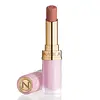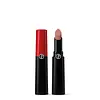What's inside
What's inside
 Key Ingredients
Key Ingredients

 Benefits
Benefits

 Concerns
Concerns

 Ingredients Side-by-side
Ingredients Side-by-side

Dimethicone
EmollientSynthetic Wax
AbrasiveIsononyl Isononanoate
EmollientDimethicone/Vinyl Dimethicone Crosspolymer
Skin ConditioningCaprylic/Capric Triglyceride
MaskingBis-Diglyceryl Polyacyladipate-2
EmollientIsostearyl Isostearate
EmollientDiisostearyl Malate
EmollientLauroyl Lysine
Skin ConditioningCera Microcristallina
Emulsion StabilisingPolybutene
Dicalcium Phosphate
AbrasiveSynthetic Beeswax
Emulsion StabilisingAroma
Disteardimonium Hectorite
StabilisingPentaerythrityl Tetra-Di-T-Butyl Hydroxyhydrocinnamate
AntioxidantPropylene Carbonate
SolventCI 77891
Cosmetic ColorantCI 77491
Cosmetic ColorantCI 77492
Cosmetic ColorantCI 42090
Cosmetic ColorantCI 15850
Cosmetic ColorantDimethicone, Synthetic Wax, Isononyl Isononanoate, Dimethicone/Vinyl Dimethicone Crosspolymer, Caprylic/Capric Triglyceride, Bis-Diglyceryl Polyacyladipate-2, Isostearyl Isostearate, Diisostearyl Malate, Lauroyl Lysine, Cera Microcristallina, Polybutene, Dicalcium Phosphate, Synthetic Beeswax, Aroma, Disteardimonium Hectorite, Pentaerythrityl Tetra-Di-T-Butyl Hydroxyhydrocinnamate, Propylene Carbonate, CI 77891, CI 77491, CI 77492, CI 42090, CI 15850
Dimethicone
EmollientBis-Diglyceryl Polyacyladipate-2
EmollientPhenyl Trimethicone
Skin ConditioningTridecyl Trimellitate
EmollientHydrogenated Polyisobutene
EmollientCI 77491
Cosmetic ColorantCI 77891
Cosmetic ColorantHydrogenated Jojoba Oil
AbrasiveDimethicone Crosspolymer
Emulsion StabilisingMica
Cosmetic ColorantIsostearyl Isostearate
EmollientKaolin
AbrasiveParaffin
PerfumingIsohexadecane
EmollientNylon-12
Vinyl Dimethicone/Methicone Silsesquioxane Crosspolymer
Cera Microcristallina
Emulsion StabilisingCI 77492
Cosmetic ColorantPolyethylene
AbrasiveSynthetic Wax
AbrasiveCI 15850
Cosmetic ColorantTriethoxysilylethyl Polydimethylsiloxyethyl Dimethicone
Skin ConditioningIsopropyl Titanium Triisostearate
EmollientCI 42090
Cosmetic ColorantAlumina
AbrasivePentaerythrityl Tetra-Di-T-Butyl Hydroxyhydrocinnamate
AntioxidantOlea Europaea Fruit Oil
MaskingTocopherol
AntioxidantCitric Acid
BufferingDimethicone, Bis-Diglyceryl Polyacyladipate-2, Phenyl Trimethicone, Tridecyl Trimellitate, Hydrogenated Polyisobutene, CI 77491, CI 77891, Hydrogenated Jojoba Oil, Dimethicone Crosspolymer, Mica, Isostearyl Isostearate, Kaolin, Paraffin, Isohexadecane, Nylon-12, Vinyl Dimethicone/Methicone Silsesquioxane Crosspolymer, Cera Microcristallina, CI 77492, Polyethylene, Synthetic Wax, CI 15850, Triethoxysilylethyl Polydimethylsiloxyethyl Dimethicone, Isopropyl Titanium Triisostearate, CI 42090, Alumina, Pentaerythrityl Tetra-Di-T-Butyl Hydroxyhydrocinnamate, Olea Europaea Fruit Oil, Tocopherol, Citric Acid
Ingredients Explained
These ingredients are found in both products.
Ingredients higher up in an ingredient list are typically present in a larger amount.
This ingredient is lipid-based synthetic skin-conditioning agent derived from adipic acid and a mixture of fatty acids. It is often called a lanolin substitute.
As an emollient, it helps soften and hydrate the skin. Emollients create a barrier on the skin to trap moisture in.
Due to its fatty acid base, it may not be Malassezia folliculitis safe.
Learn more about Bis-Diglyceryl Polyacyladipate-2Cera Microcristallina isn't fungal acne safe.
Ci 15850 is the pigment color red. It is an azo dye and created synthetically.
Azo dyes need to be thoroughly purified before use. This allows them to be more stable and longer-lasting.
This ingredient is common in foundations, lipsticks, and blushes. This color is described as brown/orangey red.
It has many secondary names such as Red 6 and Red 7. According to a manufacturer, Red 6 usually contains aluminum.
Learn more about CI 15850Ci 42090 is a synthetic dye created from petroleum. It is used to give a bright blue color to cosmetics, medicine, and food.
Ci 77491 is also hydrated iron III oxide. It's sole purpose is to give a red/pink hue to products.
Iron III oxides are classified as inorganic chemicals for coloring.
Synthetically created Ci 77491 is considered safer than those naturally found. This is because the synthetically created version may contain less impurities. Iron oxides are generally non-toxic and non-allergenic.
Learn more about CI 77491Ci 77492 is also hydrated iron III oxide. It's sole purpose is to give a yellow hue to products.
Iron III oxides are classified as inorganic chemicals for coloring.
Synthetically created Ci 77492 is considered safer than those naturally found. This is because the synthetically created version may contain less impurities. Iron oxides are generally non-toxic and non-allergenic.
Learn more about CI 77492Ci 77891 is a white pigment from Titanium dioxide. It is naturally found in minerals such as rutile and ilmenite.
It's main function is to add a white color to cosmetics. It can also be mixed with other colors to create different shades.
Ci 77891 is commonly found in sunscreens due to its ability to block UV rays.
Learn more about CI 77891Dimethicone is a type of synthetic silicone created from natural materials such as quartz.
What it does:
Dimethicone comes in different viscosities:
Depending on the viscosity, dimethicone has different properties.
Ingredients lists don't always show which type is used, so we recommend reaching out to the brand if you have questions about the viscosity.
This ingredient is unlikely to cause irritation because it does not get absorbed into skin. However, people with silicone allergies should be careful about using this ingredient.
Note: Dimethicone may contribute to pilling. This is because it is not oil or water soluble, so pilling may occur when layered with products. When mixed with heavy oils in a formula, the outcome is also quite greasy.
Learn more about DimethiconeIsostearyl Isostearate comes from Isostearyl Alcohol and Isostearic Acid. It is usually derived from vegetables, such as canola oil.
Isostearyl Isostearate is an emollient and helps soften skin. It can also help thicken a product.
This ingredient isn't fungal acne safe. It can be bad for oily skin.
Learn more about Isostearyl IsostearatePentaerythrityl Tetra-Di-T-Butyl Hydroxyhydrocinnamate (long name, huh?) is a synthetic antioxidant.
It is used to help stabilize other antioxidants or prevent the color from changing in a product.
As an antioxidant, it helps fight free-radical molecules. Free-radical molecules are capable of damaging our cells and other genetic material. Thus, antioxidants may reduce the signs of aging.
This ingredient is oil-soluble.
Learn more about Pentaerythrityl Tetra-Di-T-Butyl HydroxyhydrocinnamateSynthetic Wax is created from fossil fuels such as natural gas. It is used to enhance texture, adjust pH, and as an occlusive.
It may also be used as an abrasive ingredient to exfoliate the skin.
Synthetic Wax may not be fungal acne safe.
Learn more about Synthetic Wax